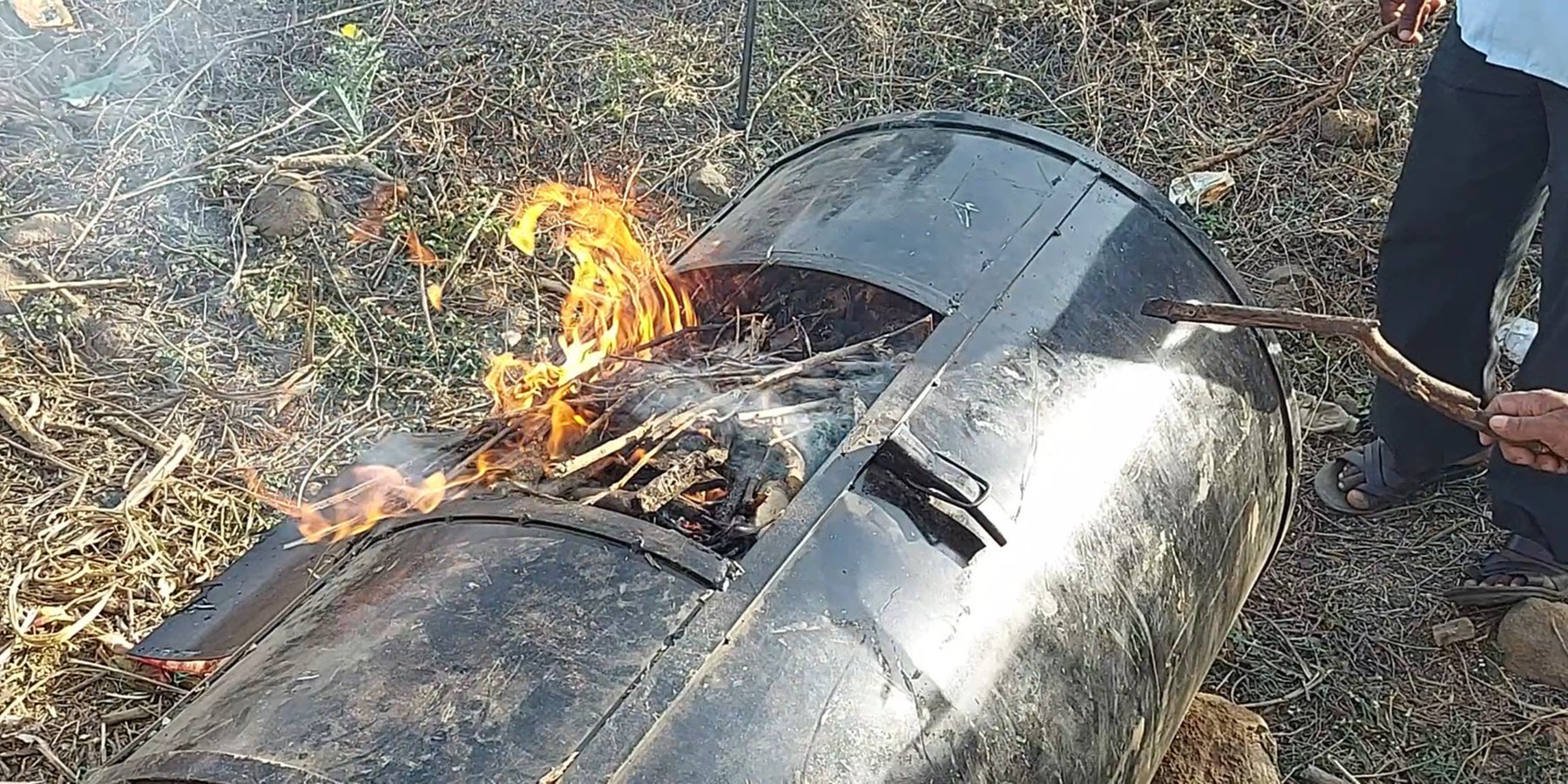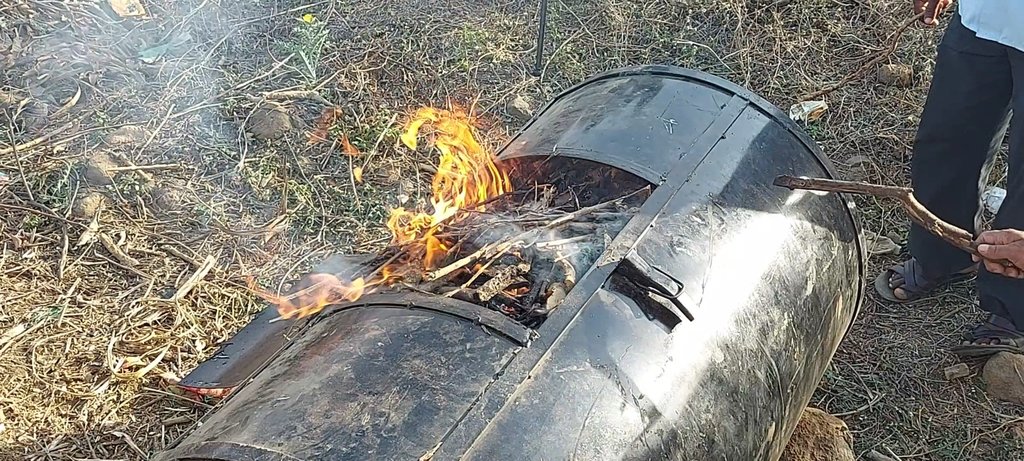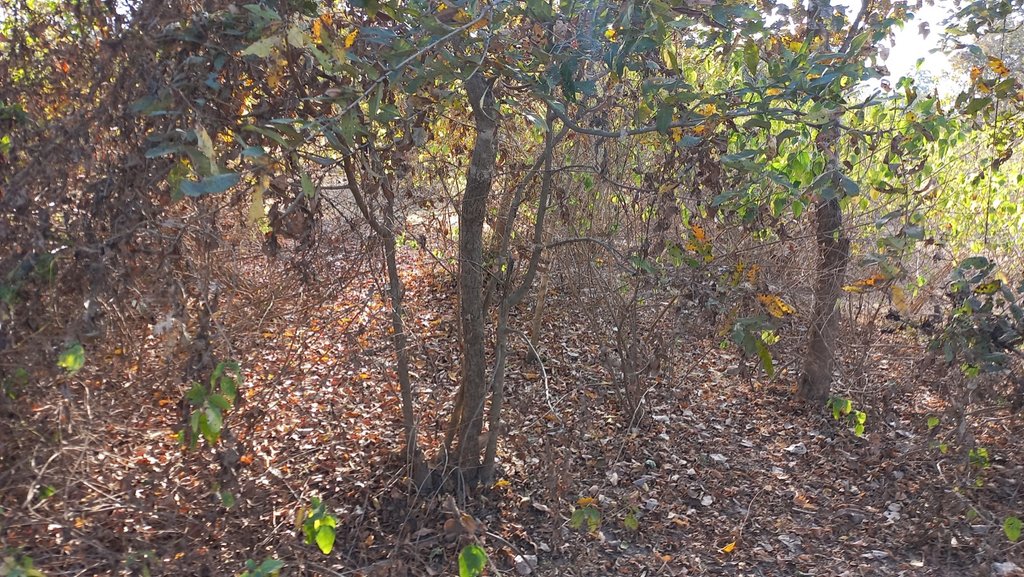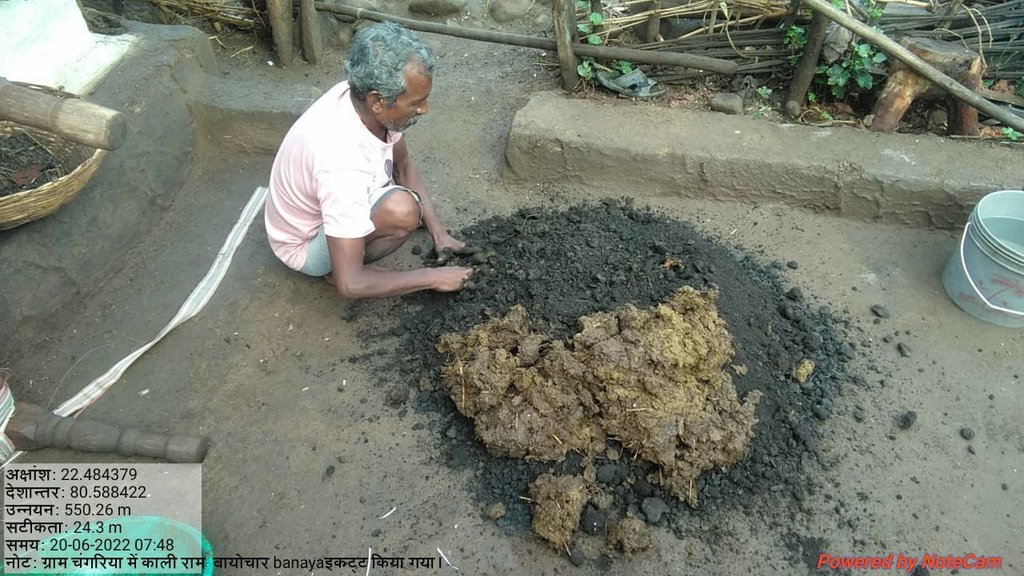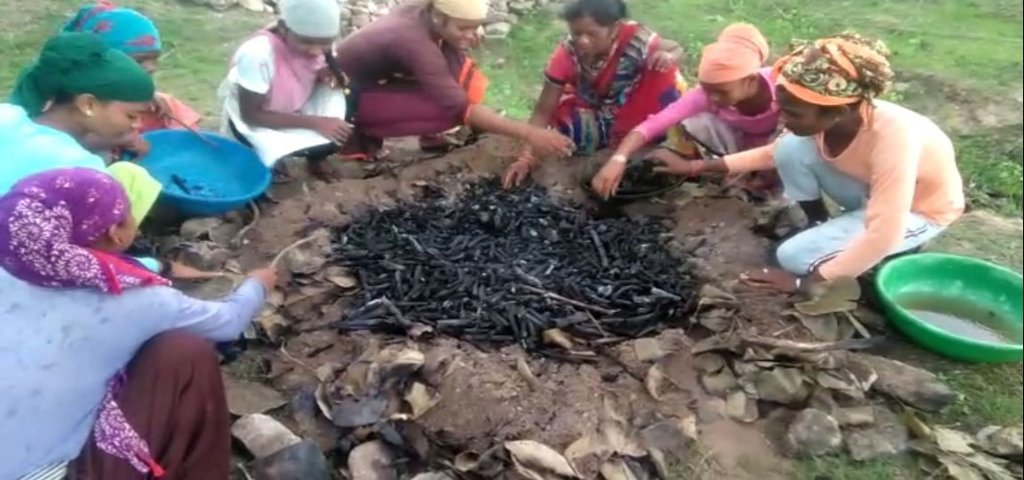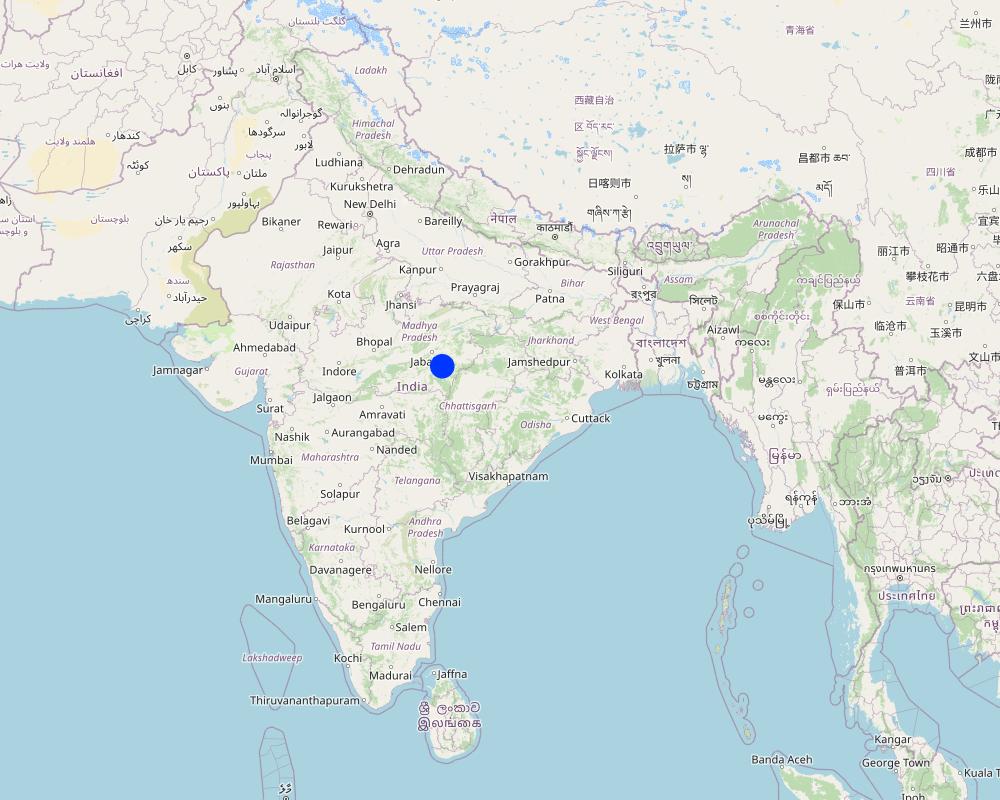Biochar Production from the Invasive Species Lantana Camara [India]
- Creation:
- Update:
- Compiler: Santosh Gupta
- Editors: Noel Templer, Stephanie Katsir, Kim Arora, Tabitha Nekesa, Ahmadou Gaye, Siagbé Golli
- Reviewers: Udo Höggel, Joana Eichenberger, Rima Mekdaschi Studer
technologies_6690 - India
View sections
Expand all Collapse all1. General information
1.2 Contact details of resource persons and institutions involved in the assessment and documentation of the Technology
Name of project which facilitated the documentation/ evaluation of the Technology (if relevant)
Soil protection and rehabilitation for food security (ProSo(i)l)Name of the institution(s) which facilitated the documentation/ evaluation of the Technology (if relevant)
Deutsche Gesellschaft für Internationale Zusammenarbeit (GIZ) - GermanyName of the institution(s) which facilitated the documentation/ evaluation of the Technology (if relevant)
CIAT International Center for Tropical Agriculture (CIAT International Center for Tropical Agriculture) - KenyaName of the institution(s) which facilitated the documentation/ evaluation of the Technology (if relevant)
Ecociate Consultants (Ecociate Consultants) - India1.3 Conditions regarding the use of data documented through WOCAT
The compiler and key resource person(s) accept the conditions regarding the use of data documented through WOCAT:
Yes
1.4 Declaration on sustainability of the described Technology
Is the Technology described here problematic with regard to land degradation, so that it cannot be declared a sustainable land management technology?
No
Comments:
The technology discusses one of the sustainable land management practices that rehabilitate soil health by eradicating invasive species of Lantana Camara and using it to prepare biochar.
2. Description of the SLM Technology
2.1 Short description of the Technology
Definition of the Technology:
Lantana Camara, an invasive species in India, negatively impacts biodiversity and agriculture. Biochar made from its biomass can help manage the species effectively. Traditionally farmers produce biochar in soil pit kilns. Another low-cost portable kiln unit of biochar preparation is a viable option for rainfed areas, designed to work on the direct up-draft principle with bottom ignition and circular vents for uniform heat transfer.
2.2 Detailed description of the Technology
Description:
Lantana Camara was introduced into India as an ornamental plant in 1809 by the British in Calcutta Botanical Garden. Lantana Camara negatively impacts biodiversity and native biota, disrupting the succession cycle, altering the structure and floral composition of native communities, and causing problems in agricultural lands in various regions of India. Its dense thickets outcompete native pastures, block the movement of grazers, and can cause poisoning. Its allelopathic activities also affect the growth of other species in its proximity. One of the measures to manage invasive species is by turning it into biochar.
Biochar is the charred biomass produced by slow pyrolysis in which organic material is heated under controlled temperatures (300-500°C) without oxygen. Lantana Camara is an ideal biomass for biochar production due to its high diversity and wide distribution. In addition to protecting ecosystems, invasive plant-derived biochar has potential applications in environmental remediation and soil amendment due to its unique structure, composition, and adsorption properties.
In the Mandla district of Madhya Pradesh, low-cost technologies for producing biochar are being practised. A low-cost portable kiln unit has been used in the Mandla District to cater to the needs of small and marginal farmers. One unit costs approximately Rs. 7000-12000 depending upon the design and location, including a metal drum, vent-making charges, and side fittings. The kiln is designed to work on the direct up-draft principle with bottom ignition. It is a vertical, single-barrel structure with a perforated base. The kiln has a square-shaped loading hole at the top, which can be closed at the end of conversion with a metal lid with a handle. The kiln has circular vents, a staggered arrangement to avoid rows, and a central vent to hold a wooden pole. Under open atmospheric conditions, the vents at the kiln base hasten hot gas movement through the bio-residues for uniform heat transfer by primary air movement. The kiln's top hole vents the released water vapours and hot gases. A strip of metal is welded around at 3/4th height of the kiln, to which two metal rods are welded on opposite sides to serve as lifting jacks. Dry Lantana Camara feedstock is placed inside the kiln unit, and a fire is lit at the bottom. Through a pyrolysis process, the organic compounds present in the biomass decompose at a specific temperature in an oxygen-limited environment.
Prior to use, the stalks/twigs of lantana are manually cut into appropriate pieces 15-19 cm long and 0.9-1.0 cm in diameter using a commonly used axe in order to achieve better packing density. Dry residues are a prerequisite to hasten satisfactory and quicker conversion. The dried residues of lantana are placed in the unit and are burned from the bottom in an oxygen-limited environment. Generally, the burning process takes 6-8 hours through a slow pyrolysis process. Once complete, the kiln is quenched with soil and left to cool for 3-4 hours. This simple and affordable biochar production method can help manage invasive plant species and benefit agriculture, the environment, and energy. The conversion ratio from biomass to biochar in the case of Lantana is around 20-25%. Farmers have reported of burning around 100 kg of dried Lantana biomass to get ~20 kg of biochar in one operation of the unit. The application rate of biochar varies from crop to crop and the type of soil and other characters. In studied project farmers do apply 20 kg of biochar mixed with 20 kg of cow dung and 20 kg of cow urine in an area of around 1 acre.
The burned biomass of Lantana after the process looks like the coal sticks, these sticks are pulverised through a pulveriser to make a powdered material for application in the field. The biochar is mixed with an equal quantity of cow dung and cow urine before the application. Some farmers also mix the native soils in biochar to get better results.
2.3 Photos of the Technology
2.4 Videos of the Technology
Comments, short description:
YouTube video accessible at https://youtu.be/MPj4_I5BFRE
2.5 Country/ region/ locations where the Technology has been applied and which are covered by this assessment
Country:
India
Region/ State/ Province:
Madhya Pradesh
Further specification of location:
Mandla
Specify the spread of the Technology:
- applied at specific points/ concentrated on a small area
Is/are the technology site(s) located in a permanently protected area?
No
Comments:
Farmers from the Mandla District of Madhya Pradesh State in India use the cost-effective technology of biochar preparation from Lantana Camara.
Map
×2.6 Date of implementation
Indicate year of implementation:
2020
2.7 Introduction of the Technology
Specify how the Technology was introduced:
- during experiments/ research
- through projects/ external interventions
Comments (type of project, etc.):
FES has worked effectively with the community to eradicate Lantana Camera from private and common land and use it for the preparation of biochar
3. Classification of the SLM Technology
3.1 Main purpose(s) of the Technology
- improve production
- reduce, prevent, restore land degradation
- conserve ecosystem
- preserve/ improve biodiversity
- create beneficial economic impact
3.2 Current land use type(s) where the Technology is applied
Land use mixed within the same land unit:
Yes
Specify mixed land use (crops/ grazing/ trees):
- Agroforestry

Cropland
- Annual cropping
Annual cropping - Specify crops:
- cereals - millet
- vegetables - other
- Fallow - maize/sorghum/millet
Number of growing seasons per year:
- 2
Is intercropping practiced?
Yes
If yes, specify which crops are intercropped:
Millets, Mustard, Mixed Vegetables, Maize
Is crop rotation practiced?
Yes
If yes, specify:
Maize-Mustard/Wheat

Grazing land
Extensive grazing:
- Transhumant pastoralism
Intensive grazing/ fodder production:
- Cut-and-carry/ zero grazing
Animal type:
- buffalo
- cattle - dairy
- goats
Is integrated crop-livestock management practiced?
No

Forest/ woodlands
- (Semi-)natural forests/ woodlands
(Semi-)natural forests/ woodlands: Specify management type:
- Dead wood/ prunings removal
- Non-wood forest use
Are the trees specified above deciduous or evergreen?
- mixed deciduous/ evergreen
Products and services:
- Timber
- Fuelwood
- Fruits and nuts
- Other forest products
- Grazing/ browsing
- Nature conservation/ protection
Comments:
Lantana camara is a highly invasive plant species that can quickly spread and take over private and common land. The plant can spread rapidly by seeds or vegetative propagation, and it can grow in various environments. This makes it difficult to control once it has established itself in an area. Lantana Camara outcompetes native plant species, reduces biodiversity and alters ecosystem processes. Additionally, the plant can be toxic to livestock and wildlife, and its dense growth can increase the wildfire risk.
3.3 Has land use changed due to the implementation of the Technology?
Has land use changed due to the implementation of the Technology?
- No (Continue with question 3.4)

Other
Specify:
Removal of Lantana and making use of its biomass for preparation of biochar
Remarks:
In the case of Lantana Camara, making biochar from the plant material can help to prevent the spread of the invasive species while also producing a helpful product. Biochar has many potential uses, including as a soil amendment, a carbon sequestration tool, and a renewable energy source.
3.4 Water supply
Water supply for the land on which the Technology is applied:
- rainfed
Comments:
Approximately 9% of the net area sown has some source of irrigation, rest is rainfed (Source, CGWB, 2013). Significantly used sources of irrigation are canals, dug well, and tanks/ponds.
3.5 SLM group to which the Technology belongs
- natural and semi-natural forest management
- agroforestry
- improved ground/ vegetation cover
3.6 SLM measures comprising the Technology

agronomic measures
- A2: Organic matter/ soil fertility

vegetative measures
- V4: Replacement or removal of alien/ invasive species

management measures
- M1: Change of land use type
- M5: Control/ change of species composition
3.7 Main types of land degradation addressed by the Technology

physical soil deterioration
- Ps: subsidence of organic soils, settling of soil
- Pu: loss of bio-productive function due to other activities

biological degradation
- Bc: reduction of vegetation cover
- Bh: loss of habitats
- Bf: detrimental effects of fires
3.8 Prevention, reduction, or restoration of land degradation
Specify the goal of the Technology with regard to land degradation:
- prevent land degradation
- reduce land degradation
Comments:
The application of biochar improves soil health by improving the soil's organic carbon and enhancing the soil's water-holding capacity
4. Technical specifications, implementation activities, inputs, and costs
4.1 Technical drawing of the Technology
Technical specifications (related to technical drawing):
Drawing of the biochar kiln developed by the expert agency
4.2 General information regarding the calculation of inputs and costs
Specify how costs and inputs were calculated:
- per Technology area
other/ national currency (specify):
INR
If relevant, indicate exchange rate from USD to local currency (e.g. 1 USD = 79.9 Brazilian Real): 1 USD =:
80.0
Indicate average wage cost of hired labour per day:
204
4.3 Establishment activities
| Activity | Timing (season) | |
|---|---|---|
| 1. | Pyrolysis of Biomass (Lantana camara) in Biochar kiln unit | October-November and June-July (Before the winter and monsoon cropping seasons). |
| 2. | Pulverisation of coal sticks received after the Pyrolysis process | October-November/June-July (Immediately after the Pyrolysis process ) |
Comments:
The availability of moisture in the soil makes the uprooting/removal of Lantana camara easy, that's the reason behind its removal in the post-monsoon season. Biochar is produced by the farmers just before the cropping seasons. Monsoon (Known as Kharif) and Winter (Known as Rabi) are the most dominant cropping seasons in India.
The establishment cost of a biochar production Kiln is low, as it is specially designed for small and marginal farmers. The unit once purchased can be used for 8-10 years with a very low maintenance cost.
4.4 Costs and inputs needed for establishment
| Specify input | Unit | Quantity | Costs per Unit | Total costs per input | % of costs borne by land users | |
|---|---|---|---|---|---|---|
| Equipment | Biochar Kiln | Number | 1.0 | 7000.0 | 7000.0 | 25.0 |
| Equipment | Pulverizer unit | Number | 1.0 | 20000.0 | 20000.0 | 25.0 |
| Total costs for establishment of the Technology | 27000.0 | |||||
| Total costs for establishment of the Technology in USD | 337.5 | |||||
If land user bore less than 100% of costs, indicate who covered the remaining costs:
The remaining cost is being covered by the project funds routed through community organisations
Comments:
The design of the biochar kiln is simple, there is hardly any cost involved in maintaining the unit. Labour cost is required generally for the removal of Lantana Camara and for the preparation of the biochar. Exact costs cannot be indicated at this time.
4.5 Maintenance/ recurrent activities
| Activity | Timing/ frequency | |
|---|---|---|
| 1. | Preparation of Biochar | Before the sowing of Rabi and Kharif season (Month of October/November and June/July) |
| 2. | Application of Biochar in the field | During the crops seasons; |
Comments:
No maintainance cost is involved in preparing biochar from Lantana Camara, as the design of the kiln is straightforward and cost-effective. Preventing the regrowth of Lantana Camara in the areas where it is removed is the only monitoring factor involved at regular intervals.
4.6 Costs and inputs needed for maintenance/ recurrent activities (per year)
| Specify input | Unit | Quantity | Costs per Unit | Total costs per input | % of costs borne by land users | |
|---|---|---|---|---|---|---|
| Labour | Labor cost for removal of lantana | ha | 1.0 | 5000.0 | 5000.0 | 25.0 |
| Labour | Preparation of biochar | Person-day | 2.0 | 200.0 | 400.0 | 100.0 |
| Labour | Application of biochar in the field | Person-day | 0.5 | 200.0 | 100.0 | 100.0 |
| Labour | Transportation of lantana | Trip | 1.0 | 200.0 | 200.0 | 100.0 |
| Fertilizers and biocides | Cow dung | kg | 20.0 | 5.0 | 100.0 | 100.0 |
| Fertilizers and biocides | Cow urine | kg | 20.0 | 5.0 | 100.0 | 100.0 |
| Total costs for maintenance of the Technology | 5900.0 | |||||
| Total costs for maintenance of the Technology in USD | 73.75 | |||||
Comments:
Recurring cost includes removing the lantana and preparing biochar, and cow dung and cow urine must be mixed with biochar before application in the field. In most cases, family members are engaged as labour.
4.7 Most important factors affecting the costs
Describe the most determinate factors affecting the costs:
Cost of the biochar kiln
5. Natural and human environment
5.1 Climate
Annual rainfall
- < 250 mm
- 251-500 mm
- 501-750 mm
- 751-1,000 mm
- 1,001-1,500 mm
- 1,501-2,000 mm
- 2,001-3,000 mm
- 3,001-4,000 mm
- > 4,000 mm
Specify average annual rainfall (if known), in mm:
1427.00
Specifications/ comments on rainfall:
Monsoon season is June-September which has the majority of the rainfall
Indicate the name of the reference meteorological station considered:
District at Glance report of Ministry of Water Resources, Central Groundwater Board, North Central Region BHOPAL, 2013
Agro-climatic zone
- sub-humid
- semi-arid
The National Bureau of Soil Survey & Land Use Planning (NBSS&LUP) developed twenty agroecological zones based on the growing period as an integrated criterion of adequate rainfall and soil groups. It delineated boundaries adjusted to district boundaries with a minimal number of regions. Mandla District of Madhya Pradesh lies in a Hot subhumid ecoregion with red and black soil. The part of the district also lies in a semi-arid region as these regions don't have irrigation facilities and the length of the growing period lies between 75-179 days.
Precepitation - 1000–1500mm; Potential Evapotranspiration -1300–1500 mm; Lenght of Growing Period-150–180days
5.2 Topography
Slopes on average:
- flat (0-2%)
- gentle (3-5%)
- moderate (6-10%)
- rolling (11-15%)
- hilly (16-30%)
- steep (31-60%)
- very steep (>60%)
Landforms:
- plateau/plains
- ridges
- mountain slopes
- hill slopes
- footslopes
- valley floors
Altitudinal zone:
- 0-100 m a.s.l.
- 101-500 m a.s.l.
- 501-1,000 m a.s.l.
- 1,001-1,500 m a.s.l.
- 1,501-2,000 m a.s.l.
- 2,001-2,500 m a.s.l.
- 2,501-3,000 m a.s.l.
- 3,001-4,000 m a.s.l.
- > 4,000 m a.s.l.
Indicate if the Technology is specifically applied in:
- not relevant
Comments and further specifications on topography:
The project area is hilly and forested (Satpura hill range) and highly undulating with narrow strips of cultivated plains in the valley portion of the river. The plateau is in the northern part, formed by basalt and east-west trending hill in the southern region. The highest elevation is 934 m amsl in the northern part, and the lowest elevation is around 400 m amsl in the northwestern part of the area. Protected forest areas cover a large majority of the site in the district as part of the Kanha National Park.
5.3 Soils
Soil depth on average:
- very shallow (0-20 cm)
- shallow (21-50 cm)
- moderately deep (51-80 cm)
- deep (81-120 cm)
- very deep (> 120 cm)
Soil texture (topsoil):
- coarse/ light (sandy)
- medium (loamy, silty)
Soil texture (> 20 cm below surface):
- medium (loamy, silty)
- fine/ heavy (clay)
Topsoil organic matter:
- low (<1%)
If available, attach full soil description or specify the available information, e.g. soil type, soil PH/ acidity, Cation Exchange Capacity, nitrogen, salinity etc.
Soil Testing Parameter status (Average) 2017-20 for the project areas is as follows. This data is based on the soil samples tested by the FES in its soil labs from the project villages.
Soil pH:- 5.906548628; EC (electrical conductivity):- 0.122993577; Soil Organic Carbon:- 0.83%; Nitrogen. :- 293.3696598; Phosphorus:- 25.77762582; Potassium (K):- 139.6696636; Sulphur (S):-18.93457993; Zinc (Zn):- 0.955246706; Boron (Bn):- 0.490850376
5.4 Water availability and quality
Ground water table:
5-50 m
Availability of surface water:
medium
Water quality (untreated):
poor drinking water (treatment required)
Water quality refers to:
both ground and surface water
Is water salinity a problem?
No
Is flooding of the area occurring?
No
Comments and further specifications on water quality and quantity:
The groundwater status is within the safe limits as per the reports by the Government of Madhya Pradesh. People use water from rivers, streams, and traditional small wells for domestic purposes. In the absence of good vegetative cover, the rainwater washes off the fertile topsoil from the farmlands making the land barren and resulting in the siltation of ponds and other water bodies. Further, a heavy infestation of invasive species such as Lantana Camara compounds the degradation.
The studied block Bichhiya is in a better position in terms of stage of groundwater development with 17%, while the average of the district is 7%. The stage of groundwater development refers to the % of groundwater being used for various purposes from the available groundwater in that area e.g. net annual groundwater availability in Bichhiya block is 9087 ham (hectare meters) while the existing annual ground water draft for all usage is 1523 ham, making it a 17% groundwater development stage.
Source: http://cgwb.gov.in/District_Profile/MP/Mandla.pdf
5.5 Biodiversity
Species diversity:
- high
Habitat diversity:
- high
Comments and further specifications on biodiversity:
The area is surrounded by Kanha National Park and Phen Wildlife Sanctuary, with a good presence of forest area. World famous Kanha Tiger Reserve is situated in the Mandla district. Kanha is famous for Tiger and Barasingha. Kanha has numerous species of insects, butterflies, reptiles, fishes, and other lesser life forms. Important mammals, birds, reptiles, crustaceans, amphibians, insects, mollusks, and fishes are found in Kanha National Park. The faunal diversity of the district represents 32 wild animals, 63 birds, 4 fishes, and 9 reptile species, respectively. Regarding floral diversity, out of 1006 plant species available in the district, 162 are tree species, followed by 71 species of shrubs, 681 species of herbs, 51 species of climbers, 39 species of grasses, and 2 species of parasites. Mandla is richer in herbaceous species than other adjoining districts like Jabalpur and Seoni.
Source:- Documentation of Biodiversity Status in Mandla District of Madhya Pradesh https://mpsbb.mp.gov.in/completedProject/MB.pdf
5.6 Characteristics of land users applying the Technology
Sedentary or nomadic:
- Sedentary
Market orientation of production system:
- mixed (subsistence/ commercial)
Off-farm income:
- > 50% of all income
Relative level of wealth:
- poor
- average
Individuals or groups:
- individual/ household
- groups/ community
Level of mechanization:
- manual work
- animal traction
Gender:
- women
- men
Age of land users:
- youth
- middle-aged
Indicate other relevant characteristics of the land users:
The large majority of the user belong to the tribal community, including some households from an ethnic community called Baiga.
https://en.wikipedia.org/wiki/Baiga_tribe
5.7 Average area of land used by land users applying the Technology
- < 0.5 ha
- 0.5-1 ha
- 1-2 ha
- 2-5 ha
- 5-15 ha
- 15-50 ha
- 50-100 ha
- 100-500 ha
- 500-1,000 ha
- 1,000-10,000 ha
- > 10,000 ha
Is this considered small-, medium- or large-scale (referring to local context)?
- small-scale
5.8 Land ownership, land use rights, and water use rights
Land ownership:
- communal/ village
- individual, titled
Land use rights:
- individual
Water use rights:
- communal (organized)
- individual
Are land use rights based on a traditional legal system?
Yes
Specify:
The concerned authorities have issued landowners the land certificates.
5.9 Access to services and infrastructure
health:
- poor
- moderate
- good
education:
- poor
- moderate
- good
technical assistance:
- poor
- moderate
- good
employment (e.g. off-farm):
- poor
- moderate
- good
markets:
- poor
- moderate
- good
energy:
- poor
- moderate
- good
roads and transport:
- poor
- moderate
- good
drinking water and sanitation:
- poor
- moderate
- good
financial services:
- poor
- moderate
- good
6. Impacts and concluding statements
6.1 On-site impacts the Technology has shown
Socio-economic impacts
Production
crop production
Comments/ specify:
Approximately increase of 15-20% across the crops. Where biochar was used, since this has happened in multiple commodities specifying the number for any crop will not do justice.
crop quality
Comments/ specify:
Grain size, the strength of biomass and overall taste of the grains. These are the qualitative measures which can not be addressed in numbers.
land management
Water availability and quality
irrigation water availability
Comments/ specify:
Biochar maintains soil moisture thus, farmers need to use less quantity of water for irrigation.
Socio-cultural impacts
SLM/ land degradation knowledge
Ecological impacts
Biodiversity: vegetation, animals
Vegetation cover
Comments/ specify:
Lantana Camara negatively impacts biodiversity and native biota. Its dense thickets outcompete native pastures, blocks the movement of grazers, and can cause poisoning. Its eradication helps improving the vegetative cover.
plant diversity
Comments/ specify:
As the density of Lantana Camara in the forest increases, allelopathic interactions increase, and hence, species richness declines (Day et al., 2003).
invasive alien species
Comments/ specify:
The invasive alien species of Lantana Camara are removed from private and common land.
animal diversity
habitat diversity
Climate and disaster risk reduction
fire risk
6.2 Off-site impacts the Technology has shown
water availability
6.4 Cost-benefit analysis
How do the benefits compare with the establishment costs (from land users’ perspective)?
Short-term returns:
positive
Long-term returns:
very positive
How do the benefits compare with the maintenance/ recurrent costs (from land users' perspective)?
Short-term returns:
slightly positive
Long-term returns:
very positive
Comments:
The cost of biochar production is almost negligible for farmers as it is made using local resources, while the benefits are multifold in terms of crop production, quality, and soil health improvement.
6.5 Adoption of the Technology
- 1-10%
Of all those who have adopted the Technology, how many did so spontaneously, i.e. without receiving any material incentives/ payments?
- 0-10%
Comments:
A number of farmers adopted the technology without any financial support from the project
6.6 Adaptation
Has the Technology been modified recently to adapt to changing conditions?
Yes
other (specify):
Technology
Specify adaptation of the Technology (design, material/ species, etc.):
Several farmers adopted biochar production using a traditional method of digging a pit and preparing the biochar.
6.7 Strengths/ advantages/ opportunities of the Technology
| Strengths/ advantages/ opportunities in the land user’s view |
|---|
| Communities have found biochar as an essential input to meet the nutrient requirement of their soil. They have improved the quality of their farm produce by applying biochar. |
| Preparation of Biochar using Lantana Camara has emerged as an excellent use for the invasive species, which otherwise was not having any use and was growing like fire in the area |
| Improved production of the farm produce |
| Strengths/ advantages/ opportunities in the compiler’s or other key resource person’s view |
|---|
| Biochar is an excellent input for improving soil organic carbon. It can lead to healthy soil with an improved capacity of the soil to sequester carbon. |
| Over the years, soils have degraded to a great extent in the project geography. Biochar can reverse this process. |
| Farmers can grow short-duration crops and fodder for their animals in a rainfed area, with improved soil moisture. This will help improve farmers' income. |
6.8 Weaknesses/ disadvantages/ risks of the Technology and ways of overcoming them
| Weaknesses/ disadvantages/ risks in the land user’s view | How can they be overcome? |
|---|---|
| The capacity of existing biochar kiln units is limited, and farmers have to wait for their turn | More units can be mobilized with community-based engagement and support from externally funded projects |
| Hard work and a long process involved uprooting lantana, drying, transportation, burning, and application | Communities need handholding and training about its importance and more technological advances |
| Weaknesses/ disadvantages/ risks in the compiler’s or other key resource person’s view | How can they be overcome? |
|---|---|
| In the long run, the easy accessibility of Lantana may be a concern if it is implemented on a large scale. The availability of other biomass is very much limited. | An assessment of the availability of Lantana and its annual requirement for biochar preparation can be done |
| Biochar has long-term benefits, while communities look for short-term solutions | Handholding the communities along with linking them with carbon credit-related projects may be a good option to keep farmers motivated |
| Regular application of biochar over the years | Regular communication with farmers about the positive outcome aligned with other financial incentives linked to soil organic carbon improvement |
7. References and links
7.1 Methods/ sources of information
- field visits, field surveys
1
- interviews with land users
10
- compilation from reports and other existing documentation
3
When were the data compiled (in the field)?
22/02/2023
Comments:
During the field visit, detailed discussions were held with the project implementing agency, communities, and other stakeholders to understand the process and impact of the intervention.
7.2 References to available publications
Title, author, year, ISBN:
Invasive plants as potential sustainable feedstocks for biochar production and multiple applications: A review, Qianwei Feng a, Bing Wang a b c, Miao Chen a b c, Pan Wu a b c, Xinqing Lee d, Ying Xing e
Available from where? Costs?
https://doi.org/10.1016/j.resconrec.2020.105204
Title, author, year, ISBN:
Biochar for Soil Health Enhancement and Crop Productivity Improvement, Awtar Singh1*, A.P. Singh2, V. Singh1, Arijit Barman1, Sagar Vibhute1 and R.S. Tolia
Available from where? Costs?
Innovative Farming, 1(4): 137-140, 2016
Title, author, year, ISBN:
A review of Lantana camara studies in India, Neena Priyanka*,**, P. K. Joshi*
Available from where? Costs?
International Journal of Scientific and Research Publications, Volume 3, Issue 10, October 2013 ISSN 2250-3153
Title, author, year, ISBN:
Annual Progress Report on Promotion of Biochar in Mandla, developed by FES for the year 2021-22
Available from where? Costs?
Internal document of FES, shared as part of the project report to GIZ. This document can be obtained from the GIZ office, India
7.3 Links to relevant online information
Title/ description:
District at a glance by Central Ground Water Board
URL:
http://cgwb.gov.in/District_Profile/MP/Mandla.pdf
Title/ description:
Low cost Kiln for Biochar Production
URL:
http://www.nicra-icar.in/nicrarevised/images/Home/NICRA%20Technical%20Brochure%20Portable%20Kiln.pdf
Title/ description:
Baiga Tribes
URL:
https://en.wikipedia.org/wiki/Baiga_tribe
Title/ description:
Biochar on soil properties and crop performance
URL:
https://www.indiascienceandtechnology.gov.in/research/biochar-soil-properties-and-crop-performance
Title/ description:
Video by FES on Biochar production (Hindi)
URL:
https://www.youtube.com/watch?v=MPj4_I5BFRE
Title/ description:
A review of Lantana camara studies in India
URL:
https://www.ijsrp.org/research-paper-1013/ijsrp-p2207.pdf
Title/ description:
Low Cost Portable Kiln for Biochar Production
URL:
http://www.nicra-icar.in/nicrarevised/images/Home/NICRA%20Technical%20Brochure%20Portable%20Kiln.pdf
Links and modules
Expand all Collapse allLinks
No links
Modules
No modules


